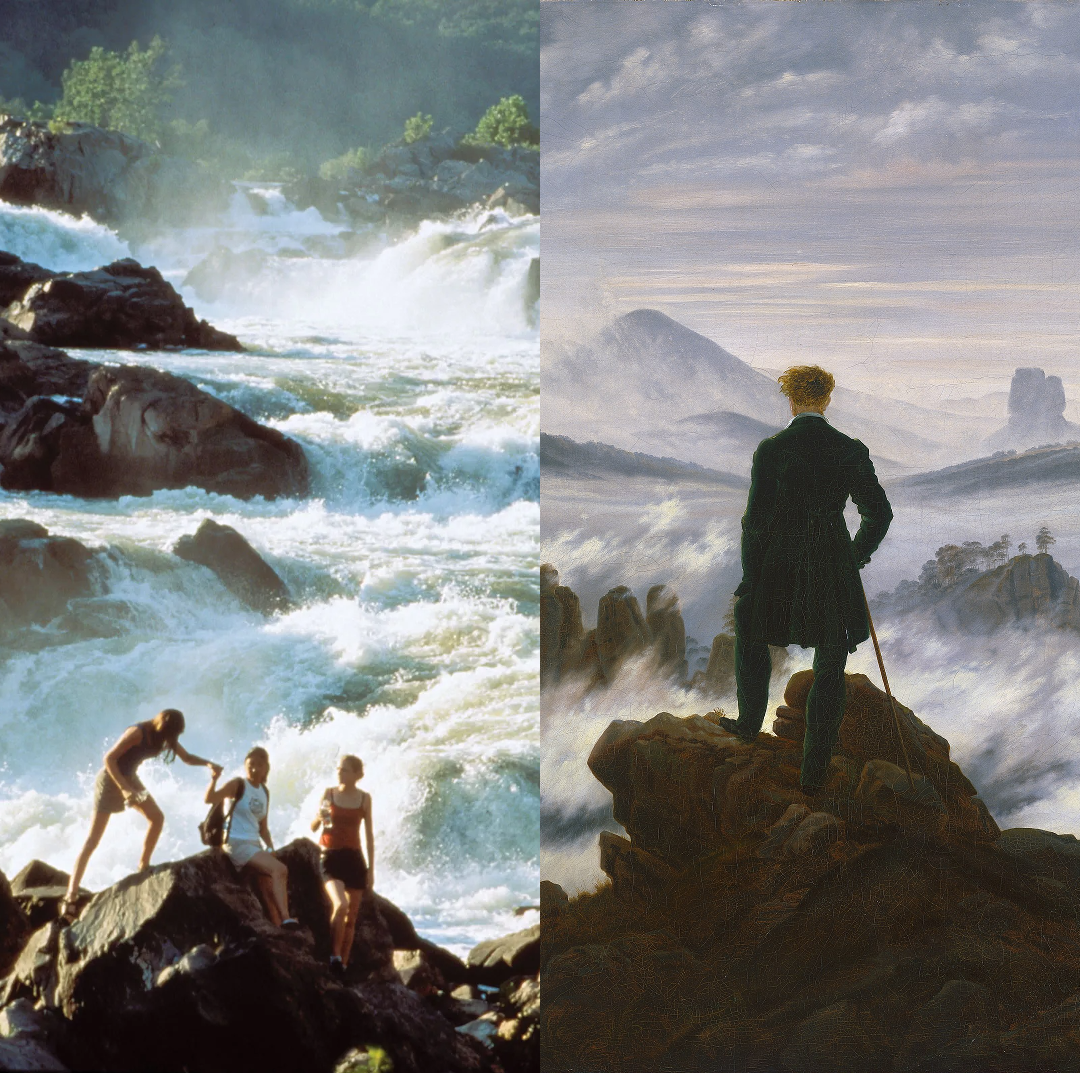The Great Falls of the Potomac, near Washington D.C., cause the river to shrink from almost 1000 feet wide to between 60 and 100 feet as it bowls through the fall-line rapids.

The Great Falls of the Potomac, near Washington D.C., cause the river to shrink from almost 1000 feet wide to between 60 and 100 feet as it bowls through the fall-line rapids.

In Friedrich's painting, we can never know whether the young man's eyes are wide, or narrow, or even closed. We never really consider they might be closed.
The three young women in front of the Falls face the camera, without looking directly towards the lens. One helps her friend - we never really doubt that they are friends - climb a small boulder by offering her hand.
Friedrich has given us a rückenfigur - a figure facing away from the viewer. His face doesn't actually exist. Even in our imagination, it is turned only towards the landscape, never towards us.
The Falls are lit with summer spray.
Friedrich assembled his scene from various field sketches - the Elbe Sandstone Mountains of Saxony and Bohemia, the Zirkelstein, the Kaltenberg, the Kaiserkrone. The landscape we see, shot with mist, can't be found anywhere on this earth.
The photograph, used by the Potomac Tourist Board to suggest that here is a place in which it's hard to be unhappy, is also of a scene that doesn't exist. The year is uncertain, but those three women will be older now. All that water's somewhere else. Even the rocks will have moved, allowing their skin to be carried, grain by grain, downstream through the Mather Gorge towards the Atlantic and whatever's beyond.
Friedrich's wanderer doesn't have any friends. He looks like he'd struggle to be happy even if he were to be transposed into the warm, gushing sun of the Falls. He's climbed the sandstone bluffs himself, needing no proferred hand, aided only by a walking stick and his restless mood.
The women in front of the Falls make their image as much about being together as it is about being in nature.
In the painting, our figure is surrounded by the mind as much as by the physical world. Of course, the two can never truly be separated, or so we are led to suspect.
Two of the three young women carry plastic water bottles. I wonder where those bottles are now? They will also have aged, though they won't yet have dissolved. Perhaps they have been healthily reformed. Perhaps they have made their way downriver to the sea, like the eroding surface of the gorge.
Friedrich's figure lives in a world without plastic and a world of lower life expectancies. Even if plastic did exist, I can't imagine it would form part of that particular wanderer's umwelt.
Roughly 15 miles from where the women are standing, decisions are being made by the President of the United States; Commander-in-Chief of the greatest military power ever to be assembled by mankind. The year is unknown, and so the leader is unknown, but we know that decisions are being made, because decisions are always being made.
Aber ein Nebel ging auf von der Erde and feuchtete alles Land. (A fog arose from the Earth and moistened the entire land.) - Genesis 2:6, The Luther Bible
Libya, Iraq, Afghanistan, Syria - who knows? Throughout the world, earth is being rearranged from the sky.
Civilian bombing, in its 20th century form, isn't a thing in Friedrich's time, though human atrocities are.
The chaos of water takes up most of the photograph, but the women appear to be on safe and solid ground.
Friedrich's painting will pass smoothly from fame into romantic cliché. It will continue to bob in our cultural pond, never really dipping beneath the surface, forever sort of there, though nothing lasts forever.
The photograph of the Potomac is not famous and probably never will be. There are no other photos like it. There are many photos like it.